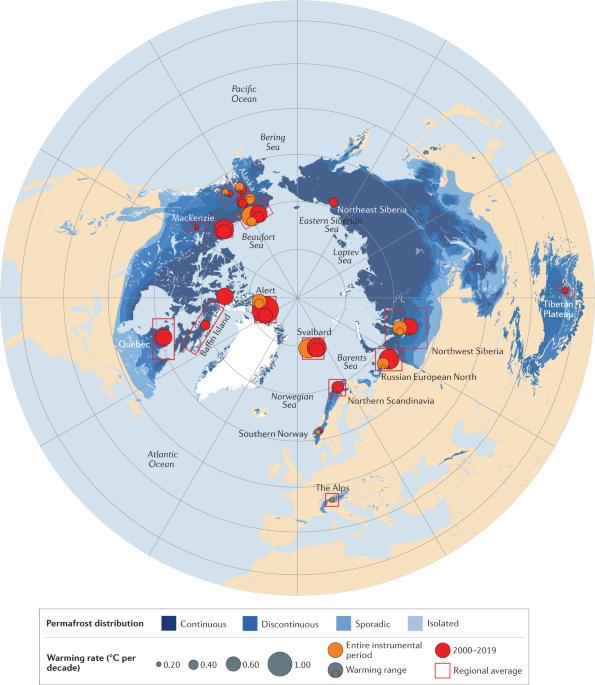The changing thermal state of permafrost
引用次数: 106
Abstract
Permafrost temperatures have increased in polar and high-elevation regions, affecting the climate system and the integrity of natural and built environments. In this Review, we outline changes in the thermal state of permafrost, focusing on permafrost temperatures and active-layer thickness. Increases in permafrost temperature vary spatially owing to interactions between climate, vegetation, snow cover, organic-layer thickness and ground ice content. In warmer permafrost (temperatures close to 0 °C), rates of warming are typically less than 0.3 °C per decade, as observed in sub-Arctic regions. In colder permafrost (temperatures less than −2 °C), by contrast, warming of up to about 1 °C per decade is apparent, as in the high-latitude Arctic. Increased active-layer thicknesses have also been observed since the 1990s in some regions, including a change of 0.4 m in the Russian Arctic. Simulations unanimously indicate that warming and thawing of permafrost will continue in response to climate change and potentially accelerate, but there is substantial variation in the magnitude and timing of predicted changes between different models and scenarios. A greater understanding of longer-term interactions between permafrost, climate, vegetation and snow cover, as well as improved model representation of subsurface conditions including ground ice, will further reduce uncertainty regarding the thermal state of permafrost and its future response. Permafrost thaw is directly governed by the thermal characteristics of the frozen ground. This Review outlines the status of and mechanisms influencing the thermal state of permafrost, revealing widespread increases in permafrost temperatures and active-layer thicknesses.

不断变化的永久冻土热状态
极地和高海拔地区的永久冻土温度上升,影响了气候系统以及自然和建筑环境的完整性。在本综述中,我们概述了永久冻土热状态的变化,重点关注永久冻土温度和活动层厚度。由于气候、植被、雪盖、有机层厚度和地冰含量之间的相互作用,永久冻土温度的增加在空间上各不相同。在较暖的永久冻土层(温度接近 0 °C),升温速度通常低于每十年 0.3 °C,如在亚北极地区观察到的情况。相比之下,在较冷的永久冻土层(温度低于-2 °C)中,每十年的变暖速度可达约 1 °C,如在高纬度北极地区观察到的情况。自 20 世纪 90 年代以来,在一些地区还观测到活动层厚度增加,其中俄罗斯北极地区的活动层厚度增加了 0.4 米。模拟结果一致表明,永久冻土的变暖和融化将随着气候变化而继续,并有可能加速,但不同模型和方案之间预测变化的幅度和时间存在很大差异。进一步了解永久冻土、气候、植被和雪盖之间的长期相互作用,以及改进模型对包括地表冰在内的地下条件的表示,将进一步减少永久冻土热状态及其未来反应的不确定性。冻土融化直接受制于冻土的热特性。本综述概述了永久冻土热状态的现状和影响机制,揭示了永久冻土温度和活动层厚度的普遍上升。
本文章由计算机程序翻译,如有差异,请以英文原文为准。
求助全文
约1分钟内获得全文
求助全文

 求助内容:
求助内容: 应助结果提醒方式:
应助结果提醒方式:


